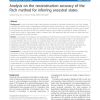77 search results - page 8 / 16 » Reconstructing Phylogenetic Networks Using Maximum Parsimony |
WABI
2004
Springer
14 years 1 months ago
2004
Springer
Computational heuristics are the primary methods for reconstruction of phylogenetic trees on large datasets. Most large-scale phylogenetic analyses produce numerous trees that are ...
ISAAC
2005
Springer
14 years 1 months ago
2005
Springer
Consider two phylogenetic networks N and N′ of size n. The tripartition-based distance finds the proportion of tripartitions which are not shared by N and N′ . This distance i...
FPL
2009
Springer
14 years 9 days ago
2009
Springer
As FPGA devices become larger, more coarse-grain modules coupled with large scale reconfigurable fabric become available, thus enabling new classes of applications to run effici...
BMCBI
2011
13 years 2 months ago
2011
Background: As one of the most widely used parsimony methods for ancestral reconstruction, the Fitch method minimizes the total number of hypothetical substitutions along all bran...
RECOMB
2004
Springer
14 years 8 months ago
2004
Springer
We present new methods for reconstructing reticulate evolution of species due to events such as horizontal transfer or hybrid speciation; both methods are based upon extensions of...

